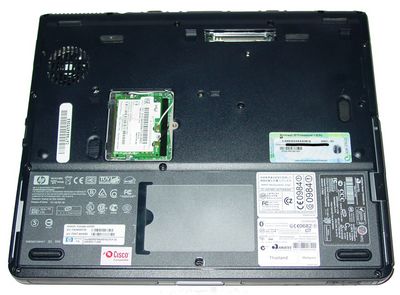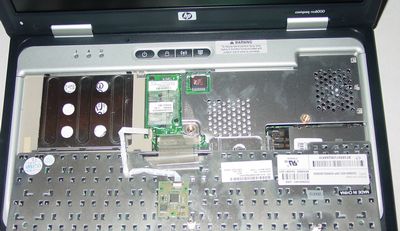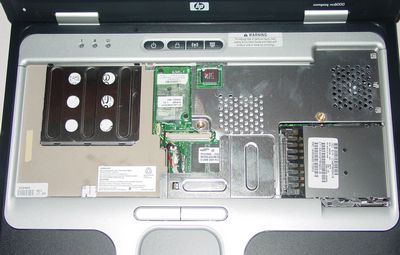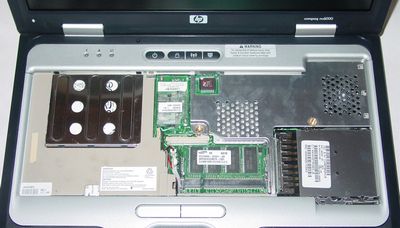Mid-sized Dothan Notebook Roundup: Dell, Gateway, and HP/Compaq
by Andrew Ku on September 30, 2004 1:09 AM EST- Posted in
- Laptops
HP Compaq NC6000: Upgrading and Maintenance
The HP/Compaq doesn't allow for much component access on the bottom side of the system. There is only a single access panel that reveals a mini-PCI slot. All of our systems came with Intel's 2200BG 802.11b/g WiFi card, including our NV6000.The keyboard is fairly typical for HP standards, but there is one thing that sets this design apart from the rest of the notebooks that have passed through the labs: keyed released design. There are four "keys"/switches on the upper portion of the keyboard that keep it locked in place. Most notebook designs incorporate the system's keyboard in a recessed manner, so removing the keyboard for maintenance, upgrading, cleaning, etc. almost always requires a screwdriver to pry it out part of the way, and thus scratching either the keyboard or the front bezel of the casing.
Dell's solution to this has been to design a small divot/recess into the front bezel of notebook's casing. This allows a user to lift out casing that secures the keyboard down (excluding the screws for the keyboard of course).
Note that there are two screws on the bottom of the system that need to be unscrewed before you can remove the keyboard by way of the four keyboard lock switches.
There are two SODIMM memory slots that can be accessed by the user, here. Because our NC6000 system came configured with 1 x 512MB memory modules, we would in theory be able to upgrade to 2GB (2 x 1GB), assuming we dished out the price premium for the SODIMM 1GB memory module.
The CPU is located in the upper right hand corner, which cannot be accessed by the user, unless the notebook is taken apart. For those curious, we understand it to be a socket design; instead of being mounted directly on the motherboard.














23 Comments
View All Comments
Monkeydonutstick - Thursday, September 30, 2004 - link
You can't be serious about comparing a Powerbook G4 to any of these. Powerbooks were owned by P3’s for Christ sake.plewis00 - Thursday, September 30, 2004 - link
I just wanted to point out as an nc6000 user that you didn't mention it's speakers (which as any Compaq user will know) are some of the best on any laptop - very rich with reasonable bass and strong volume, it easily rivals small stereos.Secondly, I don't think it's quite clear how much tougher the HP is than the Dell. I had both and pressing slightly on the Dell logo on the D600 would flex it down by about 3-4mm with very little pressure; the HP is far more robust, so it's size isn't that much of an issue (but the Dell is a bit of a headturner, the HP definitely isn't).
Also (only a small point) but given the Dell's and HP's graphics cards, a small 3D-based test (3DMark2001 SE?) wouldn't have gone amiss [that's the reason I had these machines for their size and graphics]. In seriousness, with that Gateway, what are you going to do with a 1.7Ghz Dothan CPU if not game sometimes, or that you couldn't do with a Pentium III-M 850Mhz?
manno - Thursday, September 30, 2004 - link
ksherman- "wheres the Macs? As far as im concerned, the Powerbook owns all these in terms of performance, size, weight, looks, and battery life... Its apparently even in the same price range as these "mid-sized" laptops... Bring on the Mac articles AT!"I have no clue about the technical aspect of the powerbooks size, weight, and battery life. But I do know you couldn't be more right about the looks... PLUS there's a Quake I... and I think a Quake II software renderer for Macs also... nudge nudge wink wink.
manno - Thursday, September 30, 2004 - link
SOFTWARE renderer origianl "Half-Life" or "Quake 2". Preferably Half-Life. Their software reneder is more taxing than Quake 2's. Old school, yes, but it's not biased tward desktop, or laptop video cards.peace on!... Crakers!
AndrewKu - Thursday, September 30, 2004 - link
#4 - Hopefully, we will get to that real soon.AndrewKu - Thursday, September 30, 2004 - link
#6 - Well, I hope we didn't knock it too much in the overall sense. But we are talking about the business user market segment, and we were putting more emphasis on the display more so than the other nic nacs.YaBaBom - Thursday, September 30, 2004 - link
I'm not a Gateway fan, but I think it's kind of silly to knock the Gateway laptop in the ratings because it doesn't have gigabit ethernet. Gigabit ethernet is nothing but a sales pitch as far as laptops are concerned, since the hard drives just arent capable of supplying data at gigabit speeds. I can tell you from experience that a D600 with gigabit doesnt transfer any faster than a C640 with 10/100 ethernet.brainwave64 - Thursday, September 30, 2004 - link
Great review! Very informative. It's hard to find good reviews of laptops that take into account things other than performance - like ergonomics, LED locations, battery life, weight, size, etc.--paperboy164
ksherman - Thursday, September 30, 2004 - link
wheres the Macs? As far as im concerned, the Powerbook owns all these in terms of performance, size, weight, looks, and battery life... Its apparently even in the same price range as these "mid-sized" laptops... Bring on the Mac articles AT!AndrewKu - Thursday, September 30, 2004 - link
#1 - A64 based laptops, at least so far, are those best reserved for the DTR market, and thus are focused on the performance aspect of the notebook market. If you want mobility, get a P-M based notebook.As for half-life or other gaming applications, one of these notebooks uses Intel's integrated graphic's system, so that wasn't something that was practical, and of the other two that use discrete GPUs, one uses a DX8 mobile graphics part.
#2 - Well... As far as weight and the general specs go, I think the whole market is becoming more and more grey. We will be back with a thin and light side of the Dothan market.